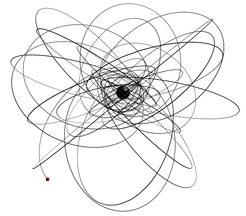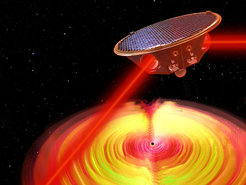What will LISA hear?
Experts discuss sources to be observed by the planned space-based gravitational-wave detector “Laser Interferometer Space Antenna” (LISA)
From 25th to 29th of June 2018, the Max Planck Institute for Gravitational Physics (Albert Einstein Institute/AEI) in Potsdam will host the 21st Capra Meeting on Radiation Reaction in General Relativity. Scientists from all around the world will meet to discuss extreme cosmic events: supermassive black holes swallowing much smaller black holes or neutron stars. These so-called Extreme Mass Ratio Inspirals (EMRIs) generate low-frequency gravitational waves, which are an important source of signals for LISA.
Capra Meetings – radiation reaction in general relativity

The Capra Meetings on Radiation Reaction in General Relativity are annual conferences, the first of which was held in 1998 at a ranch in California, which once was owned by Frank Capra, a director of Oscar awarded Hollywood movies. Capra was a Caltech alumnus and donated the ranch to Caltech.
In 2018, the meeting takes place at the AEI in Potsdam, hosted by Prof. Alessandra Buonanno’s “Astrophysical and Cosmological Relativity” division. After the 4th Capra Meeting in 2001, this is the second time the AEI hosts this conference.
The Capra meetings focus on radiation reaction in General Relativity. The motivation for this topic is twofold.
- First, from a theoretical point of view, the two-body problem in General Relativity has not been solved completely. In particular, the case where one of the two bodies is much more massive than the other is not fully understood, and attempts to solve it have led to the development of novel analytical and numerical methods.
- Second, there is great astrophysical and gravitational interest in detecting low-frequency gravitational waves with the space-based gravitational-wave observatory LISA, scheduled for launch in 2034. One of the most interesting potential sources for LISA is the gravitational radiation emitted by a compact object, such as a black hole or a neutron star, falling into a supermassive black hole, like the one in the centre of our galaxy.
Gravitational-wave sources for LISA

Dr. Maarten van de Meent, senior scientist in Buonanno’s division and chair of the organizing committee explains: “Radiation reaction is the back reaction on a body due to the emission of radiation (e.g., gravitational waves). Calculating it when the body moves in curved space-time poses a real challenge. In our meeting we will focus on calculating the effective radiation-reaction force felt by an object when orbiting around a million times more massive object. A prototypical example of this is a stellar mass black hole of the kind observed by LIGO and Virgo with about 30 solar masses orbiting a supermassive black hole of a million solar masses in the center of a galaxy.”
Alessandra Buonanno, one of the meeting’s organizers, says: “During the last years the gravitational-wave community has made important progress towards efficient and accurate calculations of EMRI waveforms. These advances are crucial because successful searches, precise inference of astrophysical and gravitational properties, and correct identifications of sources depend on our detailed knowledge of the expected signals.
Please note:
Public talk on Monday, 25th June, at 7:00 pm, lecture hall Max Planck Campus
Prof. Karsten Danzmann will give a public talk (in German), entitled “Einsteins Gravitationswellen – Wir können das dunkle Universum hören!”. Danzmann is director at the AEI in Hannover and director of the Institute for Gravitational Physics at Leibniz Universität Hannover.













